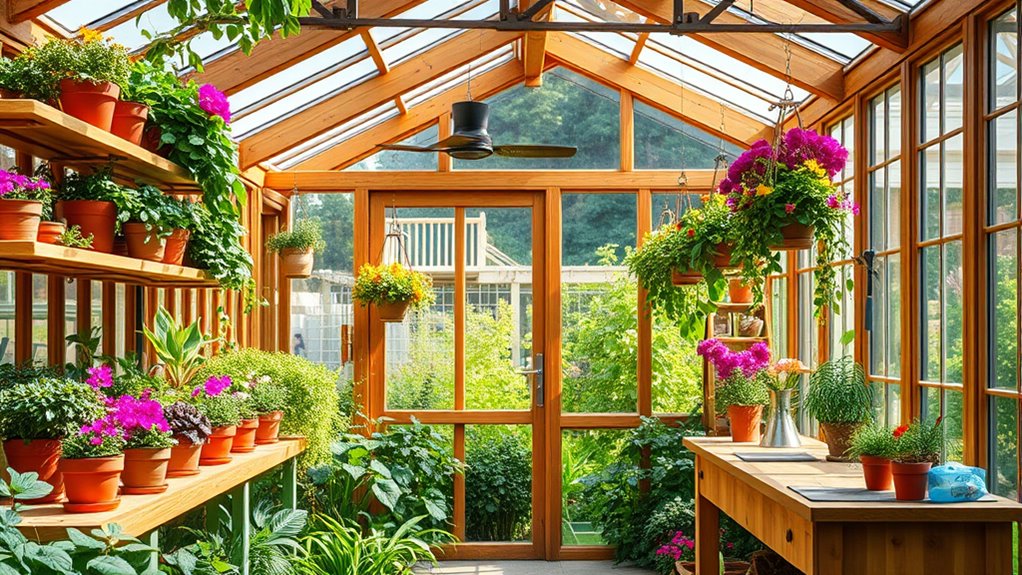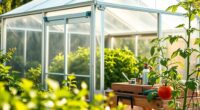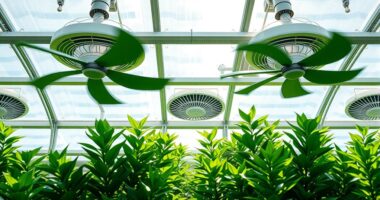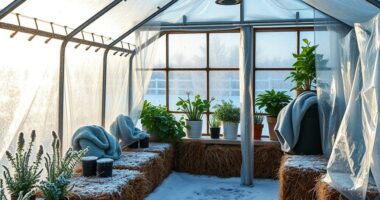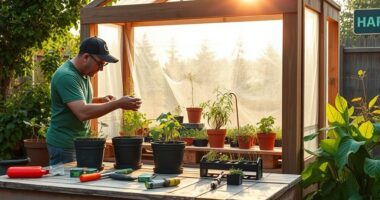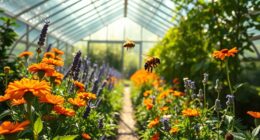Customizing your greenhouse design means choosing the right frame material, like aluminum or galvanized steel, for durability. You’ll want to consider glazing options, such as polycarbonate or glass, for optimal light transmission and insulation. Don’t forget the base walls and roof; both should offer protection and energy efficiency. You can also integrate educational spaces or choose features for commercial use. There’s so much more to explore in creating your perfect greenhouse environment.
Key Takeaways
- Determine the primary purpose of your greenhouse to guide layout and features, whether for education, commercial use, or community engagement.
- Choose appropriate frame materials, such as aluminum for durability or PVC for affordability, based on your environmental conditions and budget.
- Select glazing options that optimize light transmission and insulation, considering glass for aesthetics or polycarbonate for durability and cost-effectiveness.
- Incorporate flexible layouts and advanced systems, like hydroponics and climate control, to accommodate diverse growing methods and enhance productivity.
- Plan for site preparation by ensuring a sunny, level, and well-drained location, and implement systems for ventilation, heating, and irrigation.
Selecting the Right Frame Material
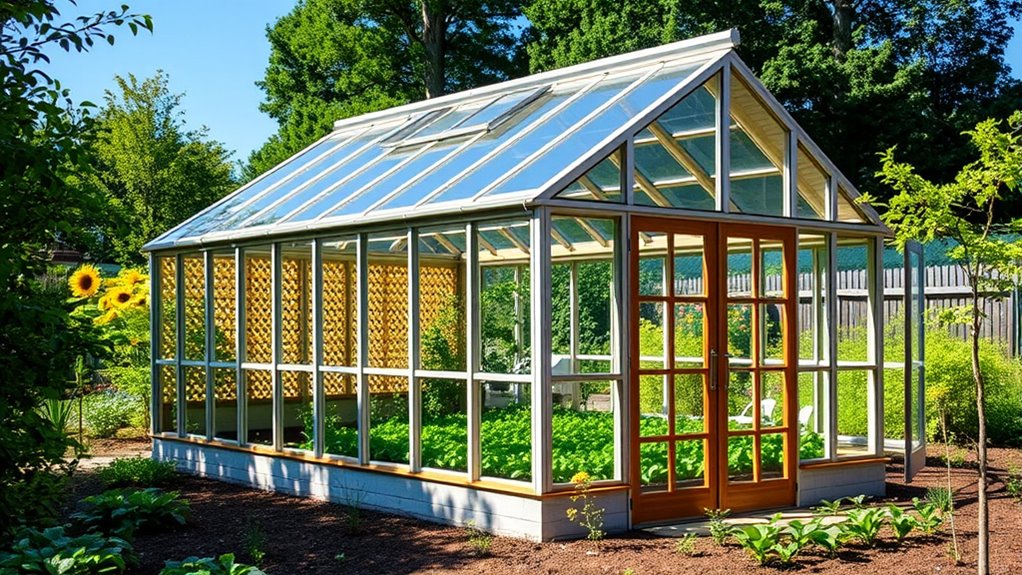
When choosing the right frame material for your greenhouse, it’s essential to consider various options that suit your needs.
Aluminum frames are lightweight and corrosion-resistant, but they can struggle in harsh weather.
Galvanized steel offers exceptional durability, making it perfect for extreme conditions, though it comes at a higher cost.
Wooden frames provide a traditional, aesthetic appeal but require maintenance to prevent rot.
If you’re on a budget, PVC frames are affordable and easy to assemble, although they lack strength.
For a balance of durability and insulation, composite frames are a solid choice, albeit often pricier.
Assess your climate, budget, and design preferences to make the best decision for your greenhouse.
Choosing the Ideal Glazing Options

Choosing the right glazing options for your greenhouse is crucial, as it directly affects light transmission, insulation, and durability.
Selecting appropriate glazing for your greenhouse is vital, influencing light, insulation, and longevity.
You have several materials to consider. Glass allows up to 90% light transmission, perfect for sun-loving plants, but it’s heavier and more expensive.
Polycarbonate offers good light transmission with excellent insulation, especially in multi-wall forms, making it a durable choice.
If budget is a concern, polyethylene film is affordable but less durable and insulating.
Acrylic provides clarity and decent insulation, though it can be pricey.
Finally, fiberglass is initially durable but may yellow over time.
Weigh each option’s pros and cons based on your climate, budget, and the plants you want to grow for the best results.
Designing Functional Base Walls

Designing functional base walls for your greenhouse is essential not only for structural integrity but also for enhancing usability and aesthetics.
These walls protect against projectiles and snow while providing a practical design element. Typically made from durable materials like block or concrete, they can be faced with brick or stone for added visual appeal.
You might consider a standard height of 32 inches for privacy and storage, or 24 inches for minimal protection. Incorporating aluminum panels offers a lightweight, customizable alternative.
Exploring Roofing Choices for Insulation
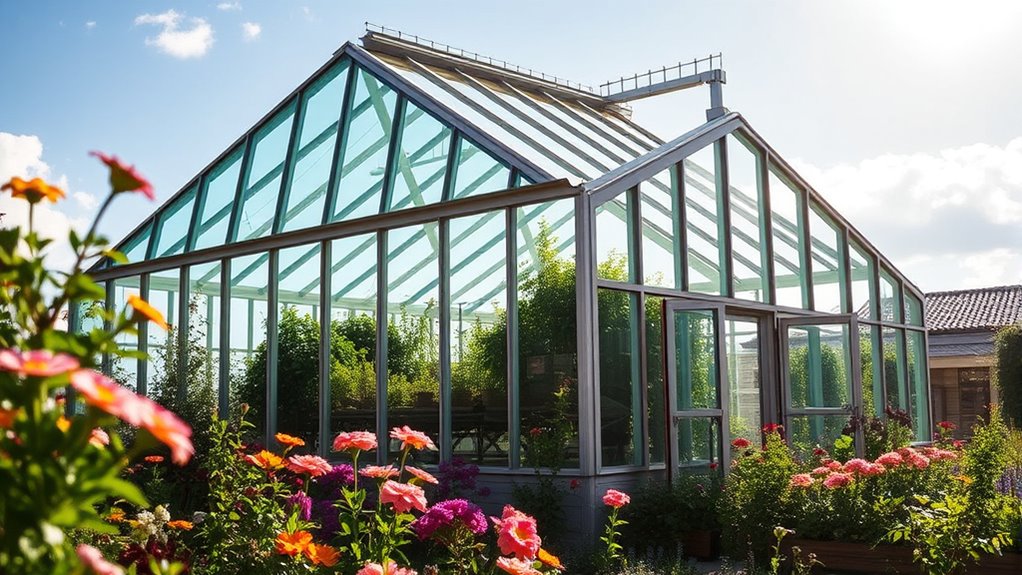
How can you ensure your greenhouse maintains a stable temperature while maximizing light exposure?
Start by choosing the right roofing material. Glass offers great light transmission but lacks insulation, so you’ll need additional measures. Polycarbonate panels are a smarter choice, providing excellent insulation and lightweight benefits. Additionally, consider applying waterproofing treatment to prevent moisture buildup, which can affect the internal environment of your greenhouse. Proper insulation is crucial for energy efficiency and helps maintain consistent temperatures. Engaging in self-reflection can also help you assess your greenhouse design needs more effectively. Furthermore, using sustainable practices in your greenhouse design can contribute to environmental conservation.
If you’re on a budget, fiberglass is a solid option, though it requires upkeep. For the most economical choice, poly film is available, but it often needs extra layers for effectiveness.
Consider dome-shaped roofs for optimal sunlight capture and snow resistance. You might also explore inflatable film greenhouses, which create a thermal air layer. Creating Your Perfect Backyard Greenhouse emphasizes that the right design can significantly influence your greenhouse’s efficiency.
Don’t forget to incorporate ventilation systems to prevent overheating while keeping your plants thriving.
Customizing Aesthetic Features

While creating a greenhouse that’s both functional and visually appealing, you can explore various aesthetic features that reflect your personal style.
Start with color options for the exterior; choose shades that harmonize with your surroundings. For glazing, consider materials like glass, polycarbonate, or polyethylene, each offering unique benefits. Select a frame style—wood for a rustic feel or aluminum for a modern touch.
Inside, enhance the decor with stylish furniture, ambient lighting like fairy lights, and elegant planters that add sophistication. Don’t forget accessories like candles or wind chimes to create a charming atmosphere.
Implementing Environmental Control Systems

Creating a visually appealing greenhouse is just the beginning; to truly enhance its functionality, implementing environmental control systems is key.
These systems regulate temperature, humidity, and lighting, mimicking natural conditions to boost plant health while reducing energy costs. You’ll benefit from automated sensors that monitor essential factors like CO2 and moisture levels, allowing for precise adjustments.
Efficient heating and cooling systems, combined with shading and fogging techniques, help maintain optimal conditions. Plus, integrating automation software means you can manage everything remotely, saving you time and effort.
Planning for Plant Growth and Maintenance
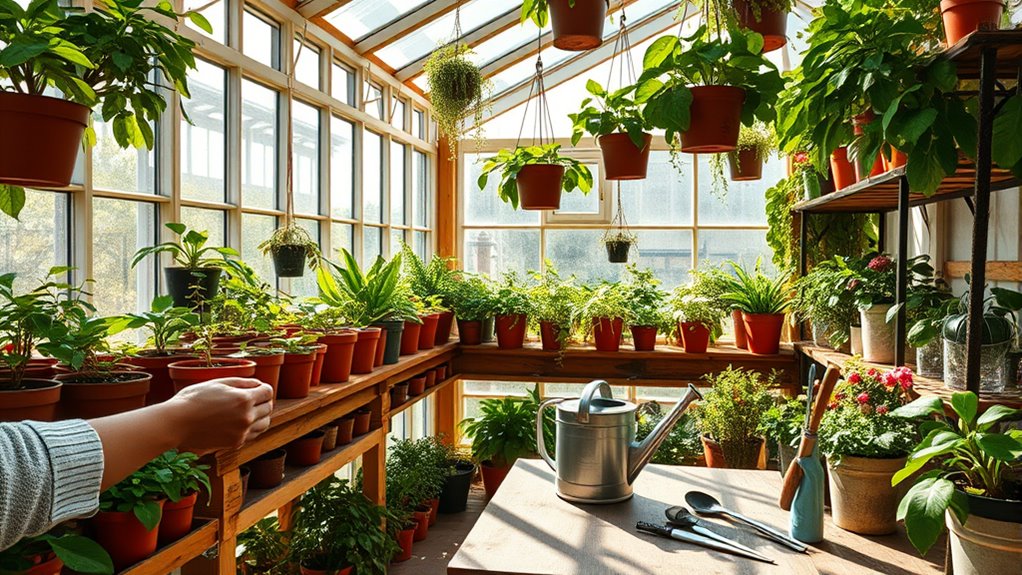
Planning for plant growth and maintenance requires careful consideration of several key factors to ensure your greenhouse is both functional and efficient.
First, position your greenhouse to maximize sunlight, ideally facing south or southeast. Allocate enough space for plants and pathways, maintaining at least two feet for easy access.
Choose a site with good drainage and quality soil to support healthy growth. Consider the specific needs of the plants you want to grow, and design for future expansion with modular components.
Optimize your layout by placing potting benches near doors and using U-shaped arrangements for accessibility. Incorporate shelving and trellising to make the most of vertical space, and utilize under-bench storage for organization. Additionally, consider using self-watering planters to minimize maintenance and promote optimal plant hydration.
Integrating Entertainment and Educational Spaces

Integrating entertainment and educational spaces within a greenhouse not only enriches the learning experience but also fosters community connections.
You can create hands-on learning opportunities by allowing students to observe plant growth and conduct experiments. Incorporating various subjects, like math and language arts, enhances the educational experience. Utilizing Montessori toys can further promote interactive learning and exploration in these settings. A focus on whole foods can inspire students to appreciate the connection between gardening and healthy eating.
Hosting public events and art classes can engage your community while blending culture and ecology. Consider offering culinary workshops to connect food with education, and provide volunteer opportunities that make gardening fun. Additionally, integrating nutritional requirements into workshops can help participants understand the importance of healthy eating habits.
Designing flexible layouts ensures that your greenhouse accommodates diverse activities, while tech integration can enhance experiences.
Understanding Commercial and Institutional Applications

Understanding the diverse applications of greenhouses in commercial and institutional settings can significantly enhance your approach to design and functionality.
In commercial settings, durable steel frames and efficient insulation help optimize productivity and reduce costs. Modular designs allow for expansion and customization, while advanced climate control systems, including hydroponics, boost crop yield.
On the institutional side, greenhouses serve educational and therapeutic purposes. You can customize these spaces for different age groups or specific needs, such as ADA compliance.
Aluminum framing and various glazing options ensure durability and low maintenance. Whether for schools or therapeutic settings, greenhouses can create multiple environments, accommodating various plant types, enhancing learning, and providing stress relief.
Navigating the Design and Installation Process

As you embark on the journey of designing and installing a greenhouse, focusing on key factors can streamline the process.
First, select a sunny, level, and well-drained location that suits your climate. Determine your budget to decide on materials and size. Clearly define the greenhouse’s purpose and the plants you want to grow, as this influences your layout and equipment needs.
Select an ideal location, set your budget, and define your greenhouse’s purpose to ensure a successful design.
Once you prepare the site, clear debris, level the ground, and test drainage. For assembly, carefully follow the manufacturer’s instructions to ensure accuracy. Choose durable frame materials and appropriate covering options.
Finally, install ventilation, heating, and irrigation systems for optimal conditions, and schedule regular maintenance to keep everything running smoothly.
Frequently Asked Questions
How Do I Choose the Best Location for My Greenhouse?
To choose the best location for your greenhouse, start by assessing sunlight exposure; you’ll need at least six hours of direct light daily.
Position it with the longest side facing south for maximum sunlight. Avoid any nearby trees or buildings that might cast shade.
Ensure easy access to water and electricity, and consider wind protection and drainage.
Lastly, check local zoning regulations to confirm you’re compliant before you begin construction.
What Are the Maintenance Requirements for Different Greenhouse Materials?
When you think of a sturdy greenhouse, wood’s charm might tempt you, but it’s high-maintenance, needing regular checks for rot.
In contrast, aluminum shines with durability and low upkeep.
Galvanized steel’s strength is impressive, yet it requires occasional inspections, while fragile PVC demands constant vigilance.
Each material has its quirks; staying on top of maintenance ensures your greenhouse thrives, no matter the frame you choose.
Regular inspections are your best friend!
Can I Incorporate Renewable Energy Sources in My Greenhouse Design?
Absolutely, you can incorporate renewable energy sources into your greenhouse design!
Consider installing solar panels on the roof to generate electricity or using wind turbines if you’re in a windy area. These options not only reduce energy costs but also ensure a reliable power supply.
Additionally, integrating passive solar design and thermal masses can help maintain a stable environment for your plants.
Embracing these methods enhances sustainability and efficiency in your greenhouse.
How Can I Ensure My Greenhouse Is Pest-Resistant?
To ensure your greenhouse is pest-resistant, start by maintaining cleanliness—remove any debris and disinfect surfaces regularly.
Implement physical barriers like fine-mesh screens on vents to keep insects out while allowing airflow.
Introduce beneficial insects and monitor your plants frequently for early pest detection.
Consider using pest-resistant plant varieties and practicing companion planting to naturally repel pests.
Lastly, limit chemical use and opt for safer alternatives when necessary to protect your environment.
What Permits Do I Need to Build a Greenhouse?
To build a greenhouse, you’ll need to check local zoning and building permits.
If your structure exceeds 120 square feet, a building permit is usually necessary. You might also need special permits for utilities or environmental concerns, especially near sensitive areas.
If your property has an HOA, get their approval as well. Always consult your local building department to ensure you have all the required permits before starting your project.
Conclusion
Customizing your greenhouse design isn’t just for the pros; you can create a space that’s uniquely yours, no matter your skill level. You might worry it’s too complicated or costly, but with careful planning and a focus on your specific needs, you’ll find that it’s an achievable and rewarding project. By considering materials, aesthetics, and functionality, you’ll craft a greenhouse that not only nurtures your plants but also enhances your gardening experience. Get started today!
